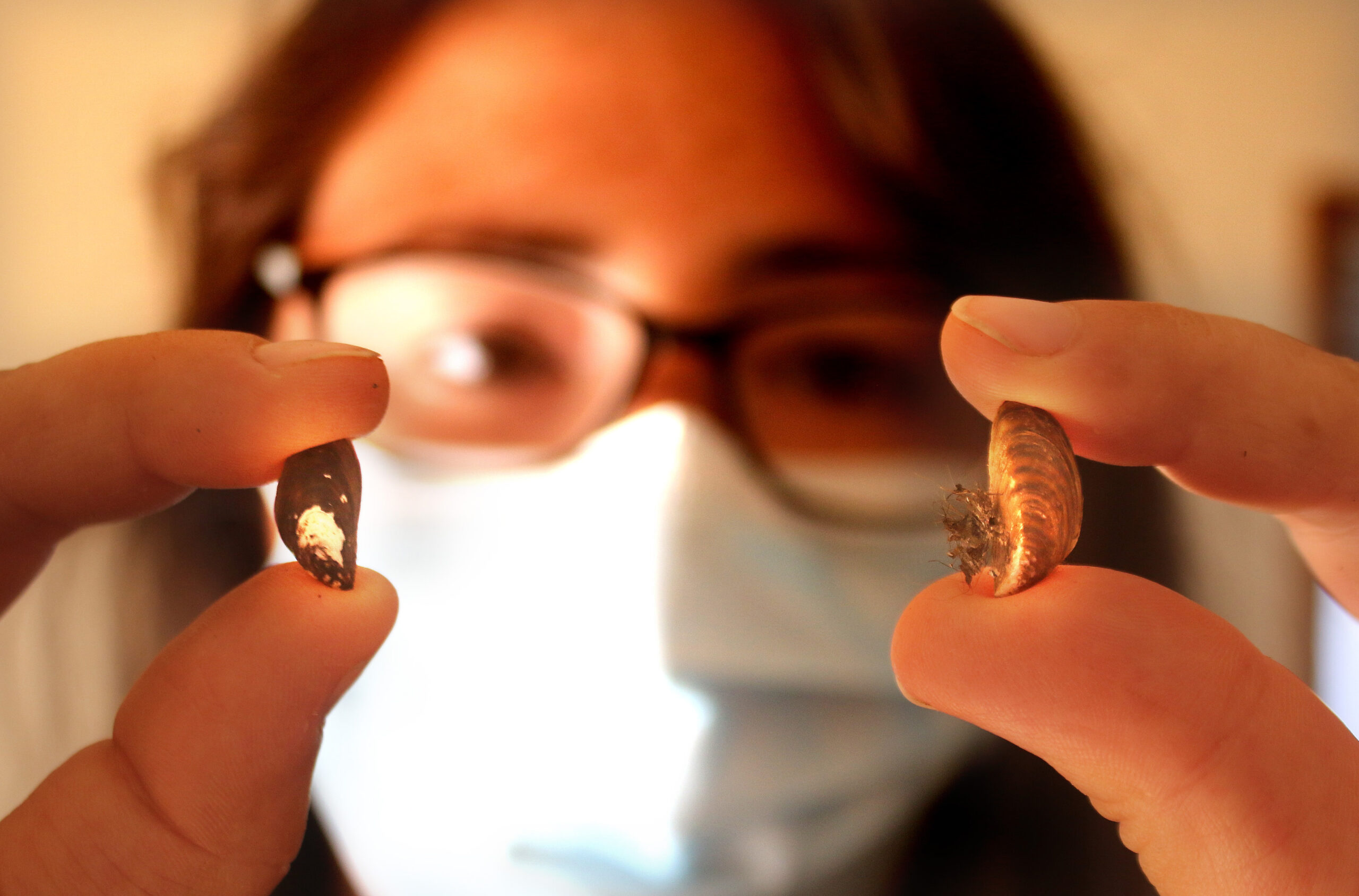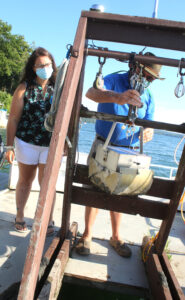Feared Quagga
Mussel Invades
BFS Researchers Locate Invasive
Worse Then Zebra, Researcher Says

By JIM KEVLIN • Special to www.AllOTSEGO.com
SUNKEN ISLAND – At 2:41 p.m. Saturday, Aug. 22, just north of here, one of Sarah Coney’s worst fears was realized.
There in a sieve that was straining a bucket of mud from Otsego Lake’s bottom was a
tiny mussel the SUNY Oneonta biology master’s candidate immediately recognized.
It was a quagga mussel, even more feared than the zebra mussel that arrived in 2008, clogging water pipes and filtering algae from Glimmerglass’ waters that cold water Otsego bass and other valued species depend on for survival.
The quagga is lighter than the zebra; also, the zebra can be placed upright on a tabletop, the quagga rolls over.

“I really didn’t want to see it,” said Coney, a native of Neversink who is preparing her thesis on the return of the American eel to the Upper Susquehanna Basin.
Sunken Island is on the lake’s north end, in a direct line between the Town of Springfield boat launch and the BFS boat house, but the new invasive is expected to spread, and fast.
In five years, “fishermen won’t have much to fish for,” said SUNY Oneonta Biology Lecturer Paul Lord, a researcher at the Otsego Lake Biological Field Station, who was aboard the BFS research craft Anodontoides when Coney made her discovery. “The lake will just get clearer and clearer.”
Both the zebra mussels and quagga mussels are filter feeders, filtering a liter a day of lake water, in the process removing plankton and algae, which other species need.
“These guys are going to filter the water so all biological activity will occur on the bottom and not in the water column,” Lord said. (The water column is the portion of the lake between the bottom and the surface.)
As is its mission, “BFS will be studying the changes that will follow this newest invasive colonization,” said Lord, and will keep the state Department of Environmental Conservation apprised of what it concludes.
When the zebra mussel arrived in 2008, normal visibility in the water was 3 meters “on a really clear day,” he continued, the relative murkiness indicating nutrients that keep a range of lake species healthy.
Since the zebras arrived, that visibility has increased to 6-7 meters, and, the other day, Lord measured 10.3 meters of visibility.
While the clarity may please some swimmers, the way the zebra mussels encrusted shallow water along the lake’s western shoreline created a danger for barefoot swimmers. They also clog water lines and engines.
The zebra has been limited the shallow water, Lord said; the quagga can inhabit the whole lake bottom, even the deep eastern shore that’s been largely free of the zebra variation now.
The lake floor “will look like a broken-up coral reef,” said Lord, “dead shells everywhere.”
The quagga is native to the Dneiper River in the Ukraine, and is believed to have arrived in North America in a freighter’s bilge sailing up the St. Lawrence River.
It was first discovered in 1989 in Port Colborne, on the Canadian side of Lake Ontario, and has since populated all the Great Lakes and hopscotched eastward through the Finger Lakes, Cayuga, Seneca.
It’s said a female quagga mussel can produce one million eggs per year; 99 percent die, but 1 percent (10,000) remain.
Lord said it’s likely microscopic mussels were brought to Otsego Lake in a bait bucket, or the bottom of a kayak or canoe that had been in, for instance, Cayuga Lake.
Despite the boat-washing program at Cooperstown’s boat launch at the end of Fish Road, Coney said boat can still enter the lake from hotels around the lake that provide directed access.


What to do?